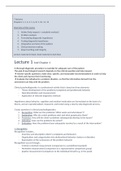7 lectures
Chapters 1, 2, 3, 4, 5, 6, 8, 9, 10, 11, 12
Overview of the course
1. Intake (help request + complaint analysis)
2. Problem analysis
3. Formulating diagnostic hypotheses
4. Testing diagnostic hypotheses
5. Integrative overview of the patient
6. Clinical decision-making
7. Report writing and integrity
Lecture material in black, book material in dark blue
Lecture 1 And Chapter 1
A thorough diagnostic procedure is essential for adequate care of the patient.
The goal of psychological research depends on the referral question and help request.
Answer specific questions; make clear, specific, and reasonable recommendations in order to help
the client and improve their functioning.
Evaluate the individual in a problem situation, so that the information derived from the
assessment can help with the problem.
Clinical psychodiagnostics is a professional activity that is based on three elements:
~ Theory development of the problems/complaints and problematic behavior
~ Operationalization and measurement
~ Application of relevant diagnostic methods
Hypotheses about behavior, cognition and emotion/motivation are formulated on the basis of a
theory, and are operationalized, measured, and tested using a step-by-step diagnostic process.
5 basic questions in clinical psychodiagnostics:
1. Recognition: What are the problems? What works and what doesn’t?
2. Explanation: Why do certain problems exist and what perpetuates them?
3. Prediction: How will the client’s problems subsequently develop in the future?
4. Indication: How can the problems be solved?
5. Evaluation: Have the problems been adequately resolved as a result of the intervention?
1. Recognition
Recognition includes…
~ Inventory and description (client’s complaints and behavior)
~ Organization and categorization into dysfunctional behavior clusters or disorders
~ Examination of the seriousness of the problem behavior
Recognition occurs through…
~ Criterion-oriented measurement (comparison to a predefined standard)
~ Normative measurement (comparison to a representative comparison group)
~ Ipsative measurement (comparison to the individual himself (e.g. in the past))
,Classification can be done according to an all-or-nothing principle, such as the DSM, or a more-or-less
principle (a profile of scores for a number of dimensions). Classification leads to ‘labeling’, which is
limited and often forms the basis for establishing co-morbidity, but it does facilitate communication
between experts.
Diagnostic formulation focuses on the individual and his or her own unique clinical picture
(description of the client and their context). Diagnostic formulation usually involves simultaneous
recognition and explanation.
2. Explanation
Explanation includes…
~ The main problem or problem component
~ The conditions that explain the problem occurrence
~ The causal relationship between the above two points
Explanations may be classified according to…
~ The locus (person or context)
~ The nature of control: cause (determined by previous conditions) vs. reason (voluntary,
intentional choice)
~ Synchronous (at the same time) and diachronous (at different times) explanatory conditions
~ Induced conditions (that give rise to a behavioral problem) and persistent conditions
(perpetuate the problem)
3. Prediction
The predictor is the present behavior and the criterion is the future behavior
4. Indication
Does the client need treatment, and if so, which caregiver and assistance are the most suitable for
this particular client and problem?
Indication does not necessarily involve selection.
5. Evaluation
Evaluation of the assertions about diagnosis and/or intervention takes place on the basis of both the
progress of the therapeutic process and the results of the treatment.
The diagnostic cycle
The diagnostic cycle is not always a linear process. It always starts with an intake and always ends
with advice, but the process in between is flexible.
,






